Imagine strolling through Rome, phone in hand, and instead of struggling to read a tiny plaque or flipping through a bulky guidebook, your screen lights up with vibrant 3D reconstructions of ancient ruins right where they originally stood.
Sounds magical, doesn't it?
This is why augmented reality is so useful in travel and tourism. AR isn't just making things better for tourists; it's also changing the way we see the world.
AR brings places to life in ways that have never been seen before, from interactive city tours to virtual hotel previews.
It blends real-world settings with digital narratives to make travel more interesting, educational, and memorable.
With AR, travel app developers and tourism businesses aren't just following a trend; they're taking a big step into the future of exploring with technology.
AR is the best answer for travelers who want unique and engaging experiences.
AR is really changing the way we see the world in travel and tourism, whether it's used to show off sites, make hotel apps better, or offer AR travel guides.
What is Augmented Reality?
Augmented Reality is a cutting-edge technology that improves the real-world environment by layering it with digital elements such as 3D models, holograms, animations, and engaging information.
Here's how AR in travel and tourism is changing the industry:
-
Immersive Exploration: Point your phone at a historical landmark and see it returned to its ancient glory with 3D animations.
-
Real-Time Guidance: Use AR-enhanced maps for natural and visual navigation.
-
Interactive Storytelling: Engage with destinations through animated stories, fun facts, and knowledge.
-
Augmented Travel Guides: Forget paper maps. AR gives smart, fast, and location-based digital guides.
-
Contextual Info on Demand: Get quick historical or cultural details simply by scanning your surroundings.
When combined into a tourism app, AR turns traditional viewing into an entertaining, fully virtual experience.
From finding hidden gems to visiting major sites, AR keeps travelers informed and amused.
Why It Matters:
-
Boosts User Engagement: Travelers spend more time exploring your app.
-
Personalized Experiences: Tailored suggestions based on interests and location.
-
Business Advantage: Stand out in a competitive market by adopting innovative tech.
Whether you're developing an AR tourism app, a travel guide with AR features, or full-blown augmented reality applications in tourism, this technology ensures that your users are not just going places but experiencing them.
For developers and tourism businesses looking to create a travel app that sticks out, the value of AR in travel apps cannot be stressed.
It's the future of travel, and the future is now.
Market Statistics and Growth of AR in Travel & Tourism
Before diving into AR development for the travel sector, it's vital to understand the market's current landscape and future potential.
Accurate data helps developers and businesses make informed decisions when building immersive AR travel solutions.
Key Market Highlights:
-
AR Market Size: The global AR market is projected to hit $88 billion by 2030, with a growing chunk focused on augmented reality in travel and tourism.
-
Rising Demand: Over 70% of millennial and Gen Z travelers prefer destinations that offer tech-driven experiences like AR travel guides, augmented reality in tourism apps, and AR tourism apps.
-
Tourism Trends: As travelers seek immersive storytelling, smart navigation, and personalized content, the role of AR in travel and tourism continues to expand rapidly.
These stats confirm that the travel industry is not just ready, but eager for an AR-powered future.
Whether you're looking to develop a custom AR travel app or integrate augmented reality in tourism apps, the time to innovate is now.
The Role of AR in Modern Travel Apps
Augmented Reality is reshaping the travel and tourism industry, turning everyday trips into amazing journeys.
As digital standards rise, the importance of AR in travel apps has become central to providing engaging, immersive, and personalized experiences that capture modern travelers.
Here are the core functions and powers that highlight the importance of integrating AR into your travel app:
► Connecting Travelers With Unique Experiences
Augmented Reality crosses the gap between digital and physical worlds, giving tourists real-time, interactive experiences suited to their location and interests.
By placing rich content such as historical facts, local insights, and user-generated reviews in real-world settings, AR helps travelers form important connections with destinations.
► Smart Navigation and Wayfinding
Traditional maps are no longer sufficient.
AR-enhanced navigation allows users to hold up their devices and quickly receive visual directions to nearby sites, hotels, restaurants, or services.
This improves movement through new environments and adds a modern touch to user journeys.
► Personalized Travel Planning
AR allows customized travel experiences based on user behavior, tastes, and trip history.
From suggesting odd spots to recommending time-sensitive events nearby, AR helps users build flexible, personalized plans that change in real-time.
► On-Demand Interaction and Support
AR features such as interactive hotel guides, virtual help desks, or museum displays with audio-visual layers improve user support.
Travelers can point their device at a landmark or hotel area and immediately access relevant information without relying on static guides or staff assistance.
► Dynamic Engagement and Storytelling
One of the most powerful elements of AR in travel apps is its ability to turn idle views into engaging learning.
Whether it's picturing ancient ruins, unlocking hidden stories at heritage places, or playing AR treasure hunts, these features drive a deeper connection and emotional interest in the destination.
► Streamlined Operations and Automation
AR technology isn't just user-facing; it also improves business processes.
Virtual check-ins, smart signs, interactive handouts, and cashless room tours are examples of how AR improves service efficiency and lowers the load on physical resources.
► Safety, Trust, and Transparency
Modern travelers value openness and security. AR can show emergency procedures, neighborhood help centers, or real-time crowd density, helping users make informed choices.
It supports trust by giving obvious, available safety and health information right when needed.
The role of AR in modern travel apps goes far beyond fancy images.
By integrating better planning tools, realistic experiences, and real-time involvement, AR has become one of the key features in travel app innovation.
It is changing how users explore the world by turning idle trips into engaging journeys that build stronger trust and lasting memories.
Types of AR Travel Apps
AR is fast changing the travel and tourism sector, giving rise to a variety of new travel apps that improve user experience and interaction.
By integrating AR into travel apps, developers are giving more dynamic, informative, and personalized experiences for modern travelers.
Below are some of the most powerful types of AR travel apps currently changing the travel and tourism industry:
1. AR Navigation Apps
Use Case: These apps use AR to provide real-time, on-screen information superimposed onto the user's surroundings via their smartphone camera.
Key Features:
-
Real-time guidance with digital lines and signs.
-
Points of interest are marked on the screen.
-
Directions to bars, landmarks, or events.
Why It Matters: This type of AR in travel and tourism improves ease of navigation in new places and removes the need to switch between maps and surroundings constantly.
2. AR Travel Guides
Use Case: Instead of reading guidebooks or handouts, users can point their phones at locations to receive realistic, interactive content.
Key Features:
-
Historical facts and fun tidbits.
-
3D reconstructions of historical places.
-
Voice narration or radio guides.
Why It Matters: Augmented reality travel guides make learning about a location both educational and enjoyable. This method boosts involvement and delivers unique travel experiences.
3. AR Tourism Apps for Attractions
Use Case: Museums, parks, heritage places, and buildings are integrating AR to improve on-site tourist experiences.
Key Features:
-
Interactive displays with stacked digital content.
-
AR stories (e.g., historical actors appearing on-screen).
-
Multilingual help for international tourists.
Why It Matters: These AR tourism apps drive higher volume, longer visit lengths, and better happiness. They're great for tourism boards, private sites, and heritage centers.
4. AR Hotel Previews
Use Case: Before booking, users can actually explore hotel rooms, hallways, and services through their mobile screens.
Key Features:
-
360° video tours of hotel rooms.
-
Interactive room details (e.g., bed size, view, services).
-
Realistic previews for openness and trust.
Why It Matters: The role of AR in tourism apps like hotel previews gives travelers peace of mind before making a booking.
It also reduces booking-related questions and increases conversion rates for hotel businesses.
5. AR Language Translators
Use Case: Tourists can quickly read foreign text, from street signs to restaurant menus, by scanning them through their smartphone.
Key Features:
-
Real-time translation is displayed on-screen.
-
Offline options for world travelers.
-
Support for multiple languages.
Why It Matters: These AR travel app features reduce language hurdles, giving a better, more confident travel experience.
They're especially popular in foreign places or with solo travelers.
Integrating these features into your platform isn't just about keeping up with trends; it's about leading the future of travel tech.
Whether it's an AR tourism app, augmented reality in a tourism app, or a full-scale AR travel app, these ideas set your answer apart in a crowded market.
While studying these developments, it's also important to evaluate the cost to develop a travel app, as it can vary based on complexity, features, and AR integration.
Top Use Cases of AR in Travel & Tourism
The impact of Augmented Reality in travel and tourism is revolutionizing how travelers explore, learn, and interact with their surroundings.
From booking to sightseeing, augmented reality applications in tourism deliver highly immersive and engaging experiences that elevate the user journey.
As AR app development services continue to evolve, travel brands are leveraging this cutting-edge technology to create dynamic, real-time interactions that enhance every stage of the travel experience.
Here are some of the most effective real-world use cases of AR in travel and tourism:
1. AR in the Hospitality Industry
Use Case: Hotels and resorts now allow potential guests to experience rooms, services, and nearby views before booking.
Benefits:
-
Virtual tours of rooms and hotel areas.
-
AR images of facilities like spas, pools, and bars.
-
Enhanced openness, leading to higher business.
Why It Works: This AR tourism app feature improves customer trust and reduces booking failure, offering a clear edge in the competitive hospitality market.
2. AR-Enhanced City Tours
Use Case: Travelers can scan sites or buildings using their smartphones to see animated historical reconstructions and audio-visual stories.
Benefits:
-
Real-time stories for city walks.
-
3D images showing how sites looked in the past.
-
Audio guides with language help.
Why It Works: These AR travel app experiences turn a simple walk into a guided, interactive trip, perfect for tech-savvy travelers who crave deeper connections with destinations.
3. Immersive Attractions through AR Tourism Apps
Use Case: Museums, heritage parks, and structures leverage augmented reality in tourism apps to add new levels of engagement.
Benefits:
-
Animated displays and participatory stories.
-
Virtual docents and guided tours.
-
Extended tourist interaction and instruction.
Why It Works: By gamifying and tailoring discovery, these apps make visits more enjoyable and boost return visits and word-of-mouth marketing.
4. AR-Powered Restaurant & Travel Route Integration
Use Case: Travelers can use AR travel app features to explore restaurant menus, view dish previews, or follow route plans with interactive elements.
Benefits:
-
Live samples of food and eating areas.
-
AR-enhanced trip planning tools.
-
Greater passenger liberty and involvement.
Why It Works: These useful uses of AR in travel and tourism improve in-app time and create more chances for upselling or partner marketing.
By integrating AR into your app, you're not just building a tool; you're creating an experience.
And if you're wondering what are the benefits of AR in travel and tourism, think enhanced engagement, real-time interactivity, and unforgettable user journeys that redefine how we explore the world.
Why Does AR Matters in the Travel Experience?
So, why all the buzz around AR in travel and tourism? Because travelers today aren't happy with just checking off destinations.
They want to connect, participate, and involve themselves in the places they visit. That's where virtual reality in tourism apps comes in.
AR changes traditional travel experiences into engaging activities. Tourists no longer settle for looking at landmarks or reading guidebooks.
They want digital experiences that answer to their curiosity with real-time information, interesting stories, and visual magic right on their screens.
Key Benefits of Augmented Reality in Tourism
-
Enhanced Learning: Travelers can absorb history, culture, and facts through engaging images, voiceovers, and animations.
-
Improved Accessibility: Language obstacles and physical limits are reduced with AR features like quick translation and guided tours.
-
Immersive Storytelling: Locations come alive with tales that users can watch, listen to, or explore in stages.
-
Real-Time Interaction: AR graphics provide appropriate content as users move, creating a personalized trip.
The importance of AR in tourism apps lies in the shift from passive viewing to active discovery.
Whether it's through an AR travel app displaying ancient ruins in their original splendour or an AR tourism app guiding users through city streets with live directions, the impact is unforgettable.
For travel businesses and app developers aiming to stand out, this translates to higher user engagement, improved retention, and a significant edge in a competitive market, making it crucial to hire dedicated developers who can create these immersive experiences.
Challenges in Implementing AR in Tourism
While the benefits of AR in travel and tourism are clear, creating impactful experiences comes with challenges.
Like any emerging technology, augmented reality in tourism apps presents technical, financial, and user-based obstacles.
Key Challenges Developers and Businesses Face
► High Development Costs
Building an engaging, high-quality AR travel app is expensive.
It takes specialized talent, advanced tech stacks, and thorough testing, especially for real-time exchanges and hyper-personalized experiences.
For newbies or small travel businesses, the initial expense can be frightening.
► Device Compatibility Issues
AR apps rely on gear like gyroscopes, high-resolution cameras, and fast computers.
Not all users have the latest apps, which can limit your audience. Ensuring cross-device efficiency is a technical problem that developers must handle early.
► GPS and Sensor Inaccuracies
Outdoor AR experiences, such as city tours or real-world navigation, depend on correct GPS and sensor data.
However, tall buildings, weather conditions, or bad signal areas can cause misalignments in digital images, negatively affecting the user experience.
► Limited User Awareness and Adoption
Although AR is getting famous, many travelers are still confused about how to use it. This lack of understanding can lower interaction and limit your app's potential.
Clear training lessons and simple UX design are important to bridge this gap.
Despite these challenges, the benefits of adopting Augmented Reality (AR) in travel and tourism apps outweigh the risks if executed well.
For businesses aiming to lead the industry, overcoming these technical and strategic hurdles is crucial, and partnering with a reliable mobile app development company in Denver can ensure a seamless and future-ready AR solution.
Scope and Future Potential of AR in Travel
The future of AR in travel and tourism is highly changing.
With advancements in 5G connections, AI-driven tailoring, and wearable technology, augmented reality in tourism apps is set to become a common necessity rather than a luxury feature.
Let's explore what lies ahead:
► Seamless Integration of AR/VR in Travel and Tourism
The lines between augmented reality and virtual reality will continue to blur, giving travelers engaging, mixed experiences.
These could include walking through digital reconstructions of ancient sites or visiting cultural events in real time.
► Smart Glasses for Hands-Free Travel
AR-enabled smart eyewear is set to change navigation and exploration. Imagine real-time images, neighborhood tips, and interactive guides, all without having to use your phone.
The role of AR in travel apps will move from screens to gadgets, creating a better and more natural experience.
► Hyper-Personalization through AI & AR
As AI app development advances, augmented reality in tourism apps will offer experiences tailored to users' tastes, travel history, and even real-time mood.
Picture AR restaurant plates that adapt to dietary needs or personalized museum tours curated through machine learning.
Why is AR Travel a Game-Changer for the Tourism Industry?
The integration of AR in travel is more than just a tech trend. It's a game-changer, redefining how people explore the world.
So, how is AR used in travel and tourism?
From gamified sightseeing adventures to real-time translation, interactive storytelling, and digital overlays on historical landmarks, AR brings destinations to life like never before.
For developers, this evolution unlocks new dimensions of creativity and user engagement.
And what are the benefits of AR in travel and tourism?
It enhances user experiences, boosts app engagement, and offers travelers a personalized, immersive journey.
Businesses that embrace AR early are positioning themselves as leaders in the next era of global tourism innovation.
How JPLoft Helps Adopt AR in Travel Apps?
The travel and tourism industry is changing quickly, and integrating Augmented Reality in travel apps is becoming a game-changer for connecting with modern travelers.
If you're ready to create an engaging, feature-rich AR travel app, now is the right time to jump.
JPLoft, the leading travel app development company, offers complete services from the initial idea to the final launch.
Our team of experts specializes in building entertaining, user-focused AR travel solutions that are safe, scalable, and built to stand out in a competitive market.
Whether it's AR-enabled navigation, interactive guides, or personalized experiences, we ensure your app meets all requirements.
We customize every project to match your unique business goals, leveraging cutting-edge technologies to deliver smooth, high-performing AR travel apps that fascinate users and drive tourism growth.
Partner with JPLoft to develop an AR travel app that delights users, improves your business, and changes how travelers explore the world.
Wrapping Up
The importance of Augmented Reality in tourism apps is undeniable; it's a necessity.
If you're a startup or business in the travel industry, now is the ideal time to embrace innovation.
With JPLoft as your tech partner, you can develop a next-generation AR travel app that delivers not only functionality but also an unforgettable user experience.
From increasing customer engagement to streamlining operations, the role of AR in modern travel apps is transformative.
Let's collaborate to bring your immersive, interactive, and future-ready travel solution to life.
Your journey to innovation starts here.
FAQs
AR is used for real-time navigation, interactive city tours, virtual hotel previews, and much more, enhancing travel apps to make experiences smarter and more engaging.
Benefits include increased user engagement, improved accessibility, enhanced learning, and immersive storytelling that brings destinations to life.
AR transforms passive sightseeing into active exploration by providing innovative features that guide, educate, and entertain travelers.
Popular examples include AR tourism apps, interactive AR travel guides, and virtual hotel room previews.
You can collaborate with experienced developers who specialize in creating scalable, immersive, and feature-rich AR travel applications.






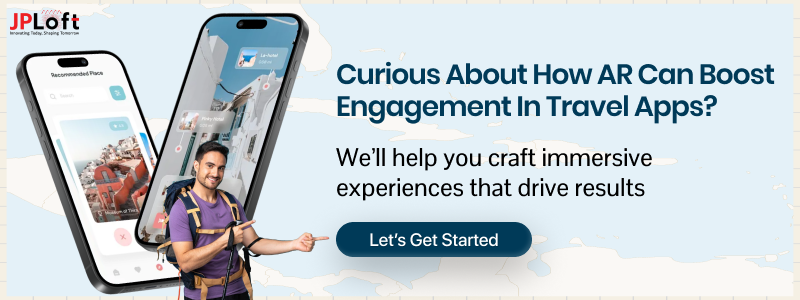
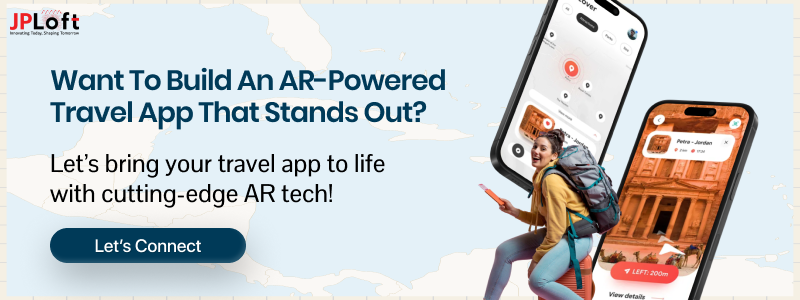

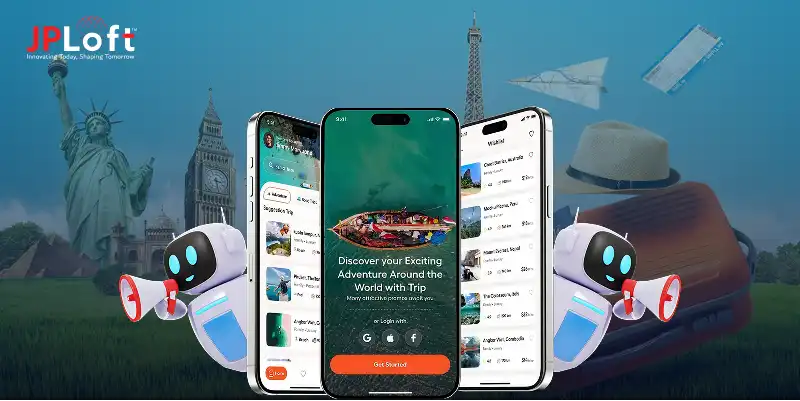
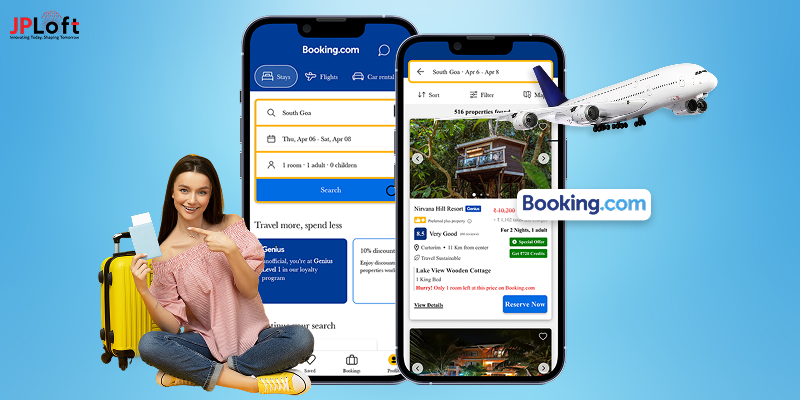
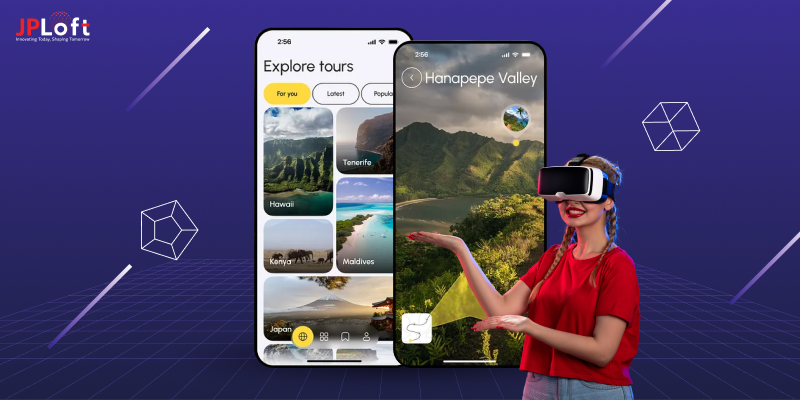


Share this blog